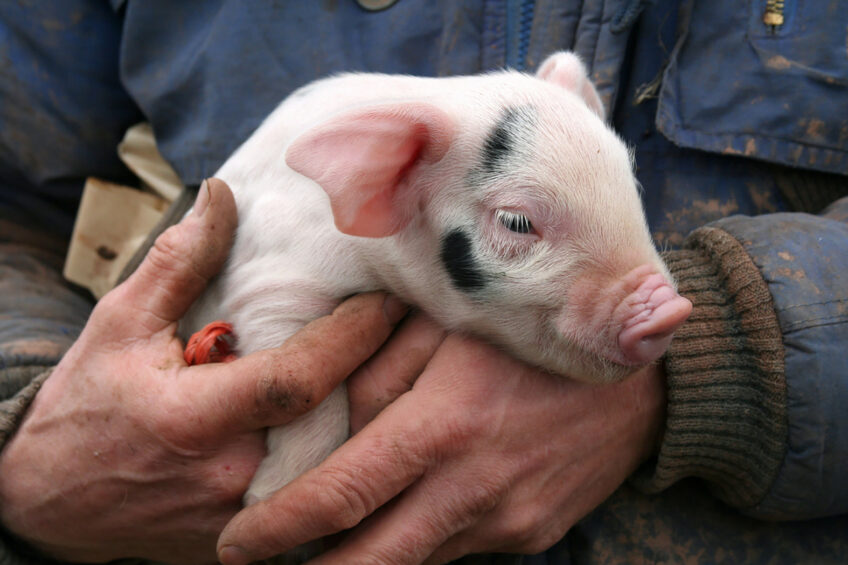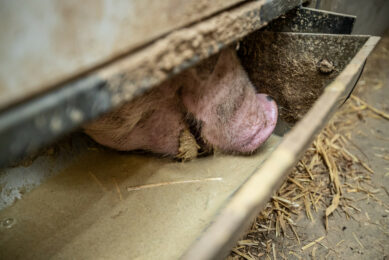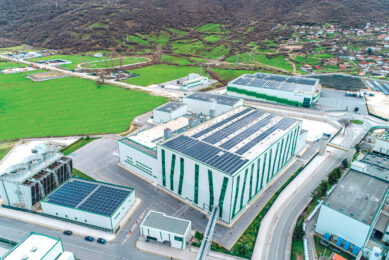Plasma: Solving piglet growth and diarrhoea dilemma

Recent studies in European pig farms show that APC’s plasma functional proteins are a key ingredient in nursery diets, helping to solve the dilemma of reducing post-weaning diarrhoea without compromising piglet growth and performance.
SUSTAINABILITY & WELFARE SPECIAL 2024 – read all articles
European post-weaning diets have undergone significant changes in response to the ban of pharmaceutical use of ZnO. These adjustments include greater use of high-quality digestible proteins, organic acids, synthetic amino acids, and a substantial reduction in overall protein levels. It is now uncommon to find commercial weaning diets with protein levels around 20%. Instead, protein levels have dropped to about 15-16%, which may negatively impact pig performance and potentially welfare during the nursery phase, leading to exit nursery body weights that fall short of the expected 24-26 kg typical of recent years. This creates a dilemma in Europe: using low-protein diets at weaning to avoid post-weaning diarrhoea (PWD) but accepting reduced performance during the nursery stage.
Spray-dried plasma
Spray-dried plasma (SDP) functional proteins have proven to be an effective and sustainable solution to this issue by promoting sustained growth and reducing health challenges. SDP is derived from blood, a by-product that would otherwise be discarded, turning it into a highly digestible functional protein. This process helps reduce waste in the meat production chain, supporting environmental sustainability. SDP can be incorporated into weaning diets to increase protein levels without raising the risk of PWD, thereby improving performance by the end of the nursery period.
Two concurrent studies were conducted at two different farms to evaluate the effectiveness of spray-dried porcine plasma (SDPP) under two different nutritional strategies using lower versus higher (normal) protein, SID lysine and ME diets fed during three nursery feed phases. Farm 1 used low protein diets in phase 1 (15.88%) phase 2 (17.10%) and phase 3 (17.5%), whereas Farm 2 used normal protein diets (20.5%, 20.0% and 18.2%) during phase 1, 2 and 3 respectively (Table 1).
The first study was conducted at Farm 1 (Commercial/research facility located in Fraga, Huesca, Spain with 8,000 pigs) where pigs were fed the low protein diets across three nursery feed phases with respective feeding durations of 14, 14 and 13 days during the 42-day study. All pigs received a common prestarter feed the day of placement before allocating them to their treatments groups the following day to start the experiment. Three treatment groups included: a Control group fed phase 1, 2 and 3 control diets without SDP; a P1SDP group fed a phase 1 diet with 3.5% SDP, followed by the control phase 2 and 3 diets; and a P1+P2SDP group fed the phase 1 diet with 3.5% SDP, a phase 2 diet with 1.5% SDP, and the control phase 3 diet. At Farm 1, 24-day-old (Danbred x Pietrain) piglets were weaned and assigned by sex and initial body weight to 12 pens/treatment with 24 pigs/pen (288 pigs/treatment; 864 total pigs).
The second study was conducted at Farm 2 (IRTA research farm, Mas Bové, Tarragona, Spain) where pigs were fed higher (normal) protein diets across three nursery phases with feeding durations of 14 d/phase in the 42-day study. As for Farm 1, there were three treatment groups including a Control, P1SDP and P1+P2SDP. The main difference at Farm 2 was that the phase 1 diet contained 5% SDP and the phase 2 diet contained 2% SDP. At Farm 2, 26-day-old ([Large White x Landrace] x Pietrain) piglets were weaned and assigned by sex and initial body weight to 8 pens/treatment with 4 pigs/pen (32 pigs/treatment; 96 total pigs).
Heavier pigs
Although the two studies were done at commercial vs research farm conditions using different pig genetics, pig health status, pigs per pen and management practices, a comparative summary of the performance differences by Farm in Table 2 provides European pig producers valuable insights into the expected outcomes of these two nutritional strategies using low or normal protein diets, particularly in the context of adding SDPP in phase 1 and/or phase 2 diets devoid of pharmaceutical levels of zinc oxide.
In the study conducted at Farm 1 using low protein diets, the performance benefits of SDPP were evident during phase 1, with higher body weight (BW), average daily gain (ADG) and average daily feed intake (ADFI) despite using a lower inclusion level of SDPP than recommended (3.5% vs 5%). However, no additional performance advantage was noted with SDPP inclusion during phase 2 other than a tendency for increased ADFI and worse FCR. By the end of the nursery phase, there were no significant differences in performance between treatments other than improved FCR in pigs fed with SDPP compared to pigs in the Control group. Nevertheless, pigs fed diets with SDPP in phase 1 and in phase 1+2 were 0.88 kg and 0.75 kg heavier than the Control pigs respectively. No incidences of diarrhoea were observed for any treatment in any period (Table 2).
Health benefits of adding SDP
Although no additional performance benefits were observed for including SDPP in phase 2 diets, pigs fed SDPP in phases 1 and 2 had numerically lower total mortality and mortality + culling than the Control group. In addition, total individual pig medications as a percentage of pigs started per group was also reduced in the P1+P2SDP group, indicating potential health benefits associated with SDPP supplementation during second phase (Table 3).
Improved overall body weight
The study conducted at Farm 2 fed diets with normal protein levels during all phases, along with the recommended SDPP inclusion levels for phases 1 and 2 (5% and 2%, respectively). During phase 1, there were no significant performance differences among treatment groups, although Phase 1 final BW, ADG, ADFI and FCR were numerically improved for the groups fed diets with SDPP, while faecal scores were low for all treatment groups.
During phase 2, pigs in the P1+P2SDP group exhibited higher BW, ADG, and ADFI compared to the CONTROL group. During phase 3, when all groups were fed an identical phase 3 control diet, pigs from the P1+P2SDP group tended to have higher phase 3 final BW, with no significant differences among groups for other parameters. The P1SDP group had intermediate BW compared to the other two groups (Table 2).
Overall, the final BW at the end of the nursery (day 42) was improved by 1.54 kg for the P1+P2SDP group and +0.31 kg for the P1SDP group compared to the Control group. Unlike Farm 1 results with low protein diets, the benefits of adding SDP during both phases may be attributed to the higher or normal protein diet strategy used at Farm 2 that did not restrict growth. No differences in faecal scores were observed among treatments in the Farm 2 study and were very low for all groups.
Although the initial BW at weaning was about 1.7 kg lower for Farm 1 vs Farm 2 pigs, there was about a 7.8 kg BW advantage at the end of the nursery for Farm 2 Control pigs (24.25 kg) fed normal protein diets vs Farm 1 Control pigs (16.45 kg) fed low protein diets, suggesting that the prolonged low protein diet strategy to reduce PWD does not fulfil the nutritional requirements of the pigs for the growth required to achieve an expected exit nursery BW of 24-25 kg. Also, under the low protein diet strategy at Farm 1, growth response to SDP in phase 1 and/or phase 2 was limited with ADG improvements only noted during phase 1 and only a tendency for heavier final BW at the end of the nursery for pigs fed SDP in phase 1 and/or phase 2 diets. In contrast at Farm 2 using a normal protein diet strategy, addition of SDP in phase 1 and 2 diets resulted in a 1.54 kg BW advantage at the end of the nursery over the control group, without any differences in faecal scores among treatment groups.
SDP: Functional and highly digestible ingredient
In summary, the results suggest that the extended low protein diet strategy used at Farm 1 (commercial farm with 8,000 pigs) excessively restricted growth of pigs such that the desired final BW was not achieved by the end of the nursery, despite being successful in keeping faecal scores and mortality low for all treatment groups with or without SDP in the feed. Furthermore, inclusion of SDP in phase 2 diets at Farm 1 tended to reduce mortality and the need for individual pig medications. Thus, the inclusion of SDP as a functional and highly digestible ingredient enables European pig producers to use normal protein diets without elevating the risk of diarrhoea. SDPP is a sustainable ingredient that favours and supports the circular economy of the meat industry.
* Article includes these authors Yanbin Shen1, Laia Blavi3, Laia Sobrevia3, Simon Tibble3, David Torrallardona4 and Joe Crenshaw1
1APC LLC, USA; 2APC-Europe, Spain; 3AB Neo Spain; 4IRTA, Spain.






